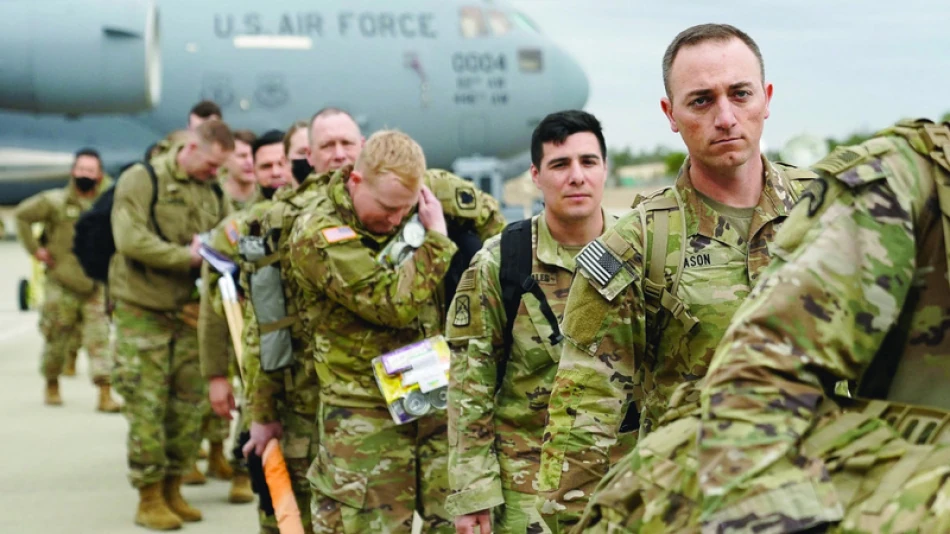
U.S. Army Experiences Surge in Recruitment Amid Changing Times
U.S. Military Recruitment Rebounds After Historic Crisis, But Political Credit Claims Miss the Mark
The U.S. military is experiencing a dramatic turnaround in recruitment after facing what the Pentagon called its worst personnel shortage in half a century. While President Trump attributes this recovery to renewed patriotism under his leadership, defense analysts point to concrete policy changes implemented years earlier—including substantial pay raises, citizenship pathways, and preparatory training programs—that are now bearing fruit.
The Recruitment Crisis That Shook the Pentagon
The scope of the military's recruitment challenges became headline news when the Army fell short of its recruitment goals by approximately 25% in fiscal year 2022. With a target of 60,000 new soldiers, the service managed to recruit only 45,000—a shortfall that sent shockwaves through defense planning circles.
The pandemic's isolation protocols played a significant role in this crisis. Military forces temporarily suspended basic training efforts, while schools and colleges—traditional recruitment grounds—remained closed to students and military recruiters alike. Katie Hiland, the Pentagon's chief recruitment officer, explained the challenge: "We had to withdraw from local communities for nearly two years. It takes time to return to those communities and rebuild those relationships."
A Generation Unprepared for Service
Beyond pandemic disruptions, fundamental shifts in American youth created additional barriers. Post-lockdown applicants showed declining scores on military entrance exams, while obesity rates and mental health diagnoses climbed. Defense officials now report that more than three-quarters of Americans aged 17-24 cannot qualify for military service without waivers for disqualifying factors.
Perhaps more concerning for military planners, a March Pentagon survey revealed that 87% of young Americans aged 16-21 said they probably or definitely do not plan to serve in the military. Two-thirds expressed concerns about the emotional or psychological impact of war, while three-quarters worried about potential physical injury or death. For the first time since the Pentagon began tracking this metric, a majority of young people had never even considered military service as an option.
The Recovery: Policy Changes Trump Political Rhetoric
Pentagon data shows military recruitment began recovering between October 2023 and September 2024—before Trump's election—with an increase of approximately 12.5%. This timeline undermines claims that political leadership changes drove the turnaround.
Instead, the recovery appears rooted in substantial financial incentives and structural reforms. Beginning in 2023, Congress approved three consecutive increases in basic military pay, ranging from 4.5% to 5.2% annually. A additional 10% increase for new recruits took effect in April, adding $3,000-$6,000 annually to each new soldier's salary. These represent the largest basic pay increases in two decades, with annual starting salaries rising from approximately $22,000 in 2022 to nearly $28,000 in 2025.
Innovation in Recruitment and Training
To address pandemic-related skill gaps, the Army created preparatory courses starting in 2022 to ready recruits for basic training, with the Navy following suit. Graduates of these programs now represent about a quarter of all Army recruits. Beth Ash, a senior economist specializing in military employment at the RAND Corporation, notes: "The armed forces and Congress have paid close attention to various policies and reforms, and we have seen marked improvement."
The services have also modernized their approach to attracting talent. Navy leaders created new career specialties like robotics, which they say appeals to young people. Quality-of-life initiatives now include everything from 24/7 gym access to improved parking facilities—recognizing that today's recruits have different expectations than previous generations.
Market Dynamics and Strategic Implications
The military's recruitment success comes against a backdrop of historically low youth unemployment, creating fierce private-sector competition for talent. This economic reality has forced military planners to compete more aggressively on compensation and benefits—a shift that mirrors corporate talent acquisition strategies.
Current recruitment numbers suggest the strategy is working. The U.S. Army now has a surplus of approximately 11,000 applicants awaiting basic training—nearly double the previous year's figure. The Air Force reports its highest surplus in a decade.
Future Challenges and Uncertainties
Analysts are closely watching whether recruitment and retention of women and minorities will be affected by the Trump administration's move away from diversity, equity, and inclusion measures. Women currently comprise nearly 18% of the active force, while Black and Latino service members represent approximately 20% and 18% respectively.
The Pentagon has launched experimental tools using artificial intelligence to improve recruiter efficiency and social media campaigns targeting parents, teachers, and other influential adults. A new Pentagon recruitment task force, combining data analysts, lawyers, and field personnel, is expected to release recommendations in August.
Lessons for Defense Planning
The military's recruitment crisis and recovery offer important insights for defense policy. The success appears driven by concrete incentives—higher pay, career opportunities, and improved quality of life—rather than political messaging or cultural positioning. This suggests that future recruitment success will depend more on the military's ability to compete as an employer than on broader political or cultural trends.
As Pentagon spokesperson Sean Barnett cautioned in June: "Recruitment numbers are excellent now, but we'll see where we stand six months from now." The sustainability of this recovery will likely depend on continued investment in compensation, training programs, and quality-of-life improvements that make military service competitive with civilian alternatives.
Most Viewed News

 Sara Khaled
Sara Khaled






